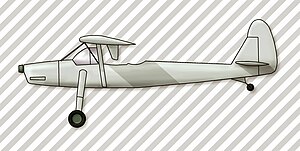Messerschmitt Bf 163
| Messerschmitt Bf 163 | |
|---|---|

|
|
| Type: | STOL aircraft |
| Design country: | |
| Manufacturer: | |
| First flight: |
February 19, 1938 |
| Commissioning: |
- |
| Number of pieces: |
1 |
The Messerschmitt Bf 163 was a propeller-driven aircraft that was submitted to the Reich Ministry of Aviation as a competition design for the Fieseler Fi 156 Storch und Flugzeugwerk Halle KG (later Siebel) Fh / Si 201 . After the draft was rejected, the number 163 was later assigned to a new project, the Messerschmitt Me 163 rocket fighter .
development
Development was initially carried out at BFW in Augsburg . A short time later, the design, for which Robert Lusser was responsible, was forwarded to the Rohrbach company in Berlin for further processing, as BFW was busy with other projects at that time. The Rohrbach company in turn transferred the construction and flying in of the Weserflug company (WFG), to which Rohrbach had belonged since 1934. In the summer of 1936, Adolf Rohrbach began working out the details in the Rohrbach factory in Berlin; the rest of the work was carried out in the WFG plant in Lemwerder , with the Delmenhorst plant also being involved in parts production. The resulting delay meant that by the time the parts began to be assembled, the stork had already been tested in Rechlin and the Reich Aviation Ministry had decided in favor of it.
The aircraft was then downgraded to initially only two pieces, and finally to only one, the first flight of which took place on February 19, 1938 with Gerhard Hubrich. This machine was used for nine more flights on February 22nd and 23rd. The planned trial at the Rechlin trial site was waived and it was returned to Augsburg in autumn 1938. On September 29, 1938, it was handed over as a teaching object to the Aviation Technical School in Munich , on the initiative of the designer Richard Bauer , who also taught aircraft construction at the school. As a special technical feature of the Bf 163, the wing with an automatic slat over the entire span and with wide deflecting flaps could change the angle of incidence in flight, so that the fuselage always maintained its horizontal position.
Technical specifications
| Parameter | Data |
|---|---|
| crew | a pilot and two observers |
| length | 9.75 m |
| span | 13.58 m |
| height | approx. 3 m |
| Wing area | approx. 25 m² |
| Empty mass | approx. 900 kg |
| Flight mass | approx. 1400 kg |
| Top speed | approx. 200 km / h |
| Minimum speed | 45 km / h |
| Range | approx. 400 km |
| Service ceiling | approx. 4500 m |
| Engines | 1 × Argus As 10C , hanging, air-cooled V8 engine with 240 PS (177 kW) starting power |
Web links
Individual evidence
- ↑ Reinhold Thiel: "Weser" aircraft construction. Hauschild, Bremen 2013, ISBN 978-3-89757-539-4 , p. 50.
- ↑ Hans J. Ebert, Johann B. Kaiser, Klaus Peters: Willy Messerschmitt - pioneer of aviation and lightweight construction. A biography. Bernard & Graefe, Bonn 1992, ISBN 3-7637-6103-9 , p. 205.
